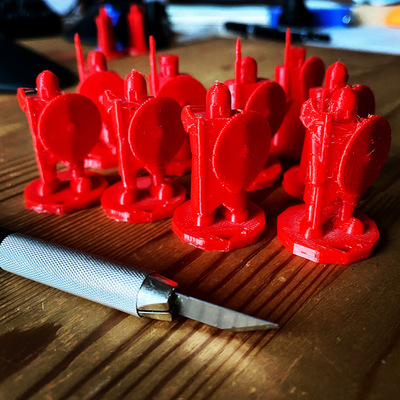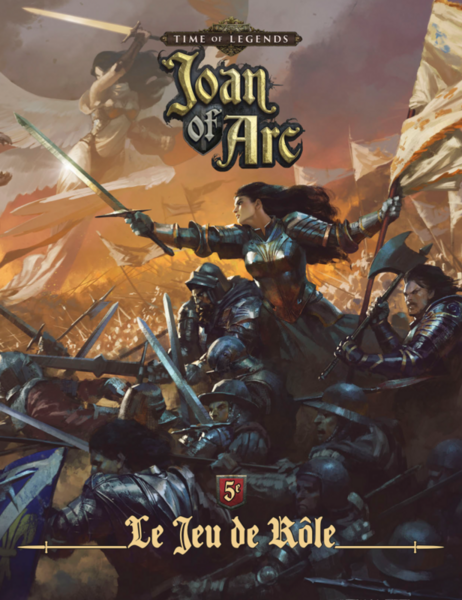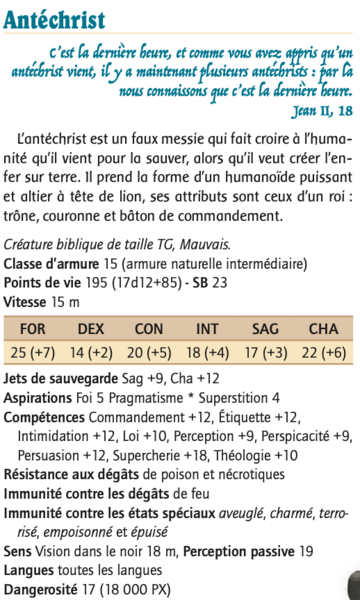
|
The Maid of Orléans |
| 2020-12-08 |
The Maid of Orléans

Despite being titled Joan of Arc, this RPG is written in French, and yes, it's set in Western Europe in the fifteenth century. It comes after the Time of Legends: Joan of Arc board game. This RPG game can be used on its own or as a 5e setting. It deserves a careful look.
It is built on the kernel of the 5th edition SRD, but some adaptations were made to fit the mood of the setting. That setting focuses on the territories disputed by the crown of France and the crown of England, but nothing prevents you from going to the Giant's Causeway, to the melancholic Granada and Constantinople, or into the mysteries of Novgorod.
The authors warn us immediately that the setting might be harsh. No healing potions, no healing magic. Fantasy is to be used carefully, somewhere between paganism and the catholic religion, as it was in the fifteenth century.
The book contains a player guide, a game master guide, and a bestiary, in 322 pages with beautiful illustrations.
Character creation lets us use a 2d8 background table were Noble and Scholar are on the extremes of the bell curve. The top of the bell is for villagers, labourer, and servants.
One can choose among twenty origins (1d20 unfortunately), German, Anglo-Norman, Lowland Burgundian, Burgundian, Byzantine, Celt, French, Hanseatic, Hungarian, Iberian, Italian, Moor, Mediterranean, Mountain person, Provençal, Scandinavian, southern Slave, eastern Slave, western Slave, or Teutonic. The book warns that most characters in that era lived and died in the same location, but, since the player characters are adventurers, they may be more exotic.
As a gamemaster, I'd probably restrict the origin to the starting region of the first campaign scenario, except for scholars and/or nobles, perhaps for kids following a mercenary army train.
Each origin has languages associated to it (for example, German has alemannic, high german, low german, old yiddish, frisian, etc), it also has "aspirations" (like "Faith", "Pragmatism", "Superstition") and accessible skills (classical 5e skills and more).
The background comes back in play here, and the player is suggested a series of personal stories and personalities. They weave in the origin to add accessible skills, "aspirations" and equipment. It prepares the ground nicely for the class selection.

There are four classes, "débrouillard" (resourceful rogue), man-at-arms, "intrigant", and "sage" (wiseman / scholar).
The débrouillard is similar to the vanilla 5e rogue, not strong enough to be a man-at-arms, not smart enough to be a sage, and not connected highly enough to be an intriguant. Covered archetypes are thief, ranger, ruffian. The man-at-arms are fighters. Archetypes are expert, bold, and leader. The "intriguant" covers archetypes like artist, adventurer, or spy. The sage archetypes are healer, cleric (religious person), and "savant".
The combat rules seem similar to the SRD they're based on. There is a wound system (all those "gritty" systems have). There are also extra mass combat rules. They can be tied into the board game.
The game master section of the book is thick with explanations of the medieval society, chronologies (my copy of A Distant Mirror there in the to-read pile is calling me), pieces of advice on how to dose the fantasy.
There is a list of relics (Longinus' holy lance, Saint Christophe's staff, etc) and then the section introduces a ritual magic system, with prayers, spells, and formulas. The book stresses that those should be kept to the game master (he might choose not to use them, or he might choose to hide the details from the players). They are comparable to dnd spells, but are paid for with points, Faith points for prayers, Superstition points for spells, and Pragmatism points for formulas.

The bestiary chapter is divided into multiple sections:
Humans covering knights, veterans, religious fanatics, farmers, highway men, plagued men, scouts, ottoman warriors, ... Full of stats directly usable in any 5e games.
Celebrities like Jeanne d'Arc, Gilles de Rais, John Talbot, Du Guesclin, The Black Prince, Giovanni Acuto, ... Those profiles are based on a single stat block, but each profile has different aspirations and feats, and a potential adjustment to the challenge rating of the base profile. The authors reminded that those celebrities levelled up too somehow.
Animals, covering war horses, travel horses, boars, wolfes, ... (note to self, read horses in the middle ages again).
Biblical Creatures like angels, archangels, the Antechrist, the beast, The Apocalypse riders, various demons, the Devil, dragons, Gog and Magog, the Leviathan, saints. Directly usable in any 5e setting, but has to be carefully compared.
Other Creatures, golem and skeleton, yes that's all, but one can easily add more from the the classical monster manual.
The book closes with a small low-level scenario called "Burning Nights", where players are confronted with a not well known sickness assimilated to a curse.
If you can read French, the PDF is currently at 10 Euros (lockdown price). It's full of good stuff, the art if beautiful, and it can enrich or be a source of inspiration for any medieval fantastic setting.
Highly recommended.
